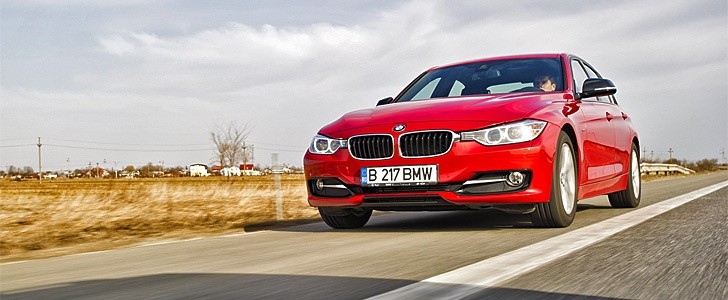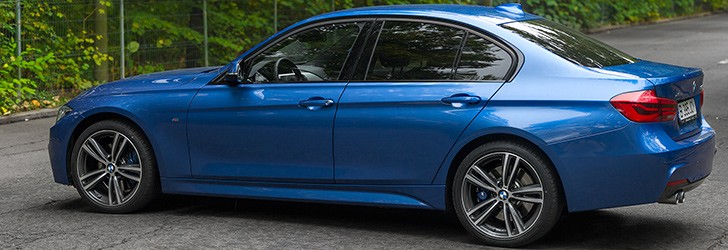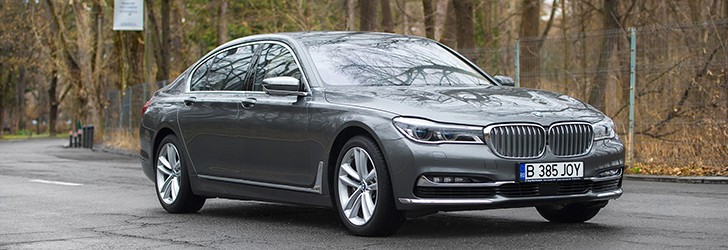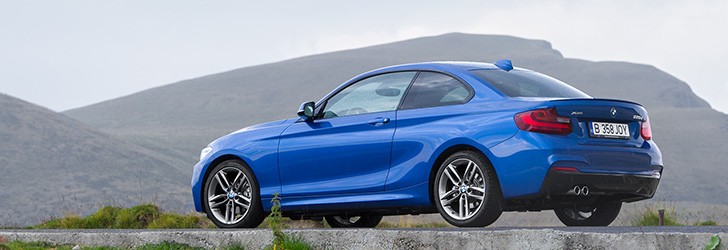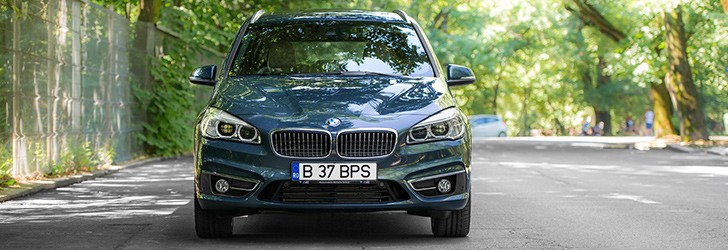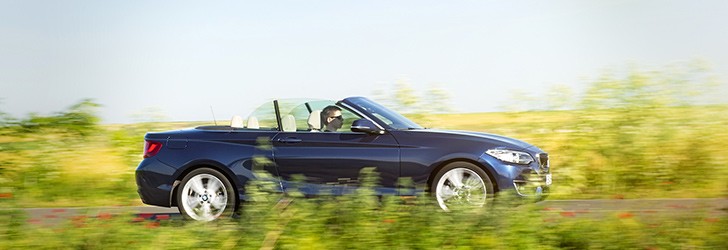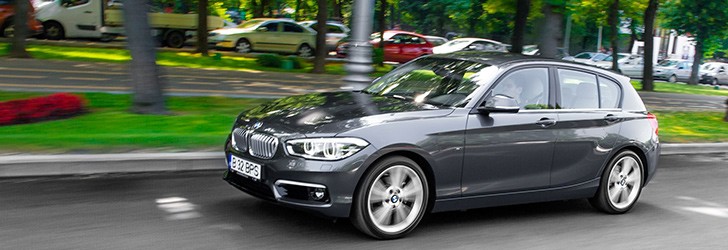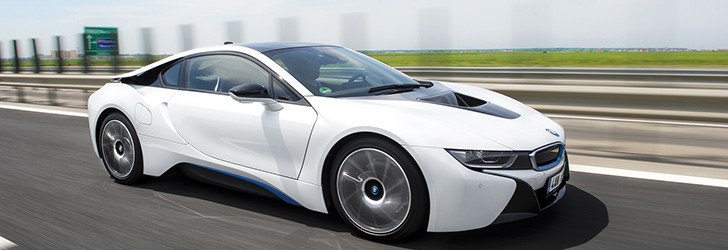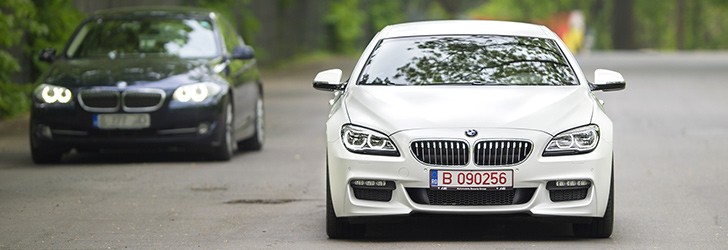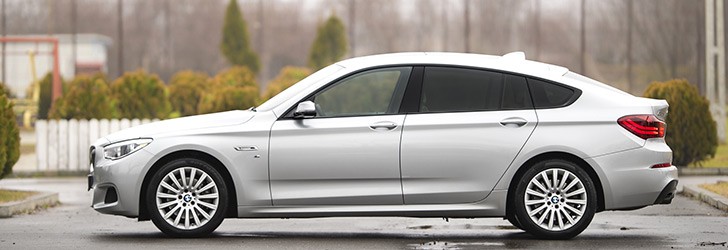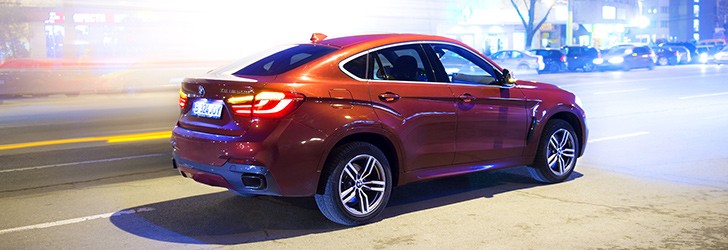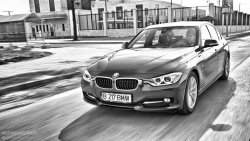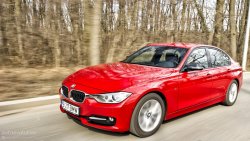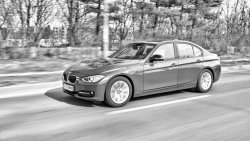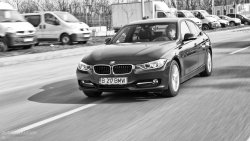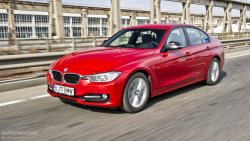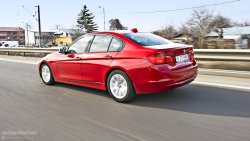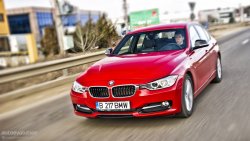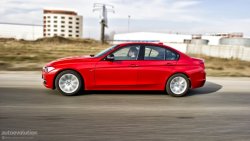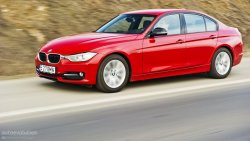BMW 3 Series Review
OUR TEST CAR: BMW 3 Series (F30) 320d Sport
We hear the pages of the history book turning as our fingers make their way back to the early 60s when BMW introduced the Neue Klasse (New Class), a range of compact sedans and coupes that basically set the foundation on which contemporary BMWs lay on. These were the common ancestors of both the 3-Series and the 5-Series and, if you ask us, it’s the first that’s stayed closer to their identity.
A bit of dust raises in the cabin as we turn the pages again, this time to 1975, when the first 3er, codenamed E21, was introduced. From there on, the vehicle grew up similarly to a human being, with the E30, E36, E46 and E90 generations following.
These are not just codes that make BMW fans dream, but also vehicles that can still be found in the automotive landscape today, proving just how fit they are for our world.
Over the years, the 3-Series has earned a reputation of being a sporty premium saloon and much more. In fact, if we lined up a small group of cars that would have to be conserved in order to stand as a proof of our civilization, the 3er would certainly be included among them.
We now close the dusty book and place it on the generous back seat of our brand-new F30 BMW 3-Series test car - it’s time to take replace the reading glasses with the sun ones and get down to business.
Today, we shall test the sixth generation of the 3er, a vehicle that has quite a burden on its fenders, as it has to step up the aforementioned game. Now that the designers and engineers have done their job, it’s time for us journalists to do ours and tell you what this piece of Germany is all about.
The vehicle we’re writing from is the one that will top the range’s sales, the 320d. However, our test car has been packed with lots of optional extras and when you check out its description you feel like someone has planned everything out for you.
The fresh 3-Series seems to laugh at the challenge we mentioned above. Just take a look at it, it seems bold and self-confident, not for a second does it show any concern for the fact that it has to raise to a sky-high level of expectations. OK Mr. Three, let’s see what you’re made of!
A quick look at the BMW range reveals that the carmaker is fully aware of the fact that it can’t just rely on driving dynamics to cater to the needs of its customers. People today have complex demands and the Bavarian have gone to great lengths to make sure they have something for everybody. Thus, the 3-Series now comes in three flavors: Sport, Modern and Luxury.
These lines, as BMW calls them, mean that you get different details for both the exterior and the interior. We drove the Sport, which means that, for example, we got high-gloss black exterior trimming.
Now that the new generation is out, we can sit down for a second and sigh in relief: it’s so nice to see how the 3-Series has managed to avoid the controversy brought by the Bangle era.
The 3-Series is now more masculine, it inspires movement even when standing still and we have to say that this is quite an achievement for a vehicle that has grown in length. The visual story spells “masculinity” and this is true from every angle of the car. But it’s not just the big picture that has a lot to tell you, the details are important too.
The most important new feature is brought by the shape of the headlights, which are now extending up to the kidney grille. Of course, BMW’s full-LED construction also offers a strong visual impression. The lower front fascia has its own identity and helps the vehicle escape the “they all look the same” issue that affects many carmakers’ ranges these days.
Of course, all the typical elements, such as the Hofmeister kink and the extremely short front overhang are there and they mix with the all-new ones, such as the complex architecture of the lower front and rear fascias, all with the aim to create an image that stands out a little bit.
To sum it all up, the 3-Series has grown in length, with 50 percent of the increase going into the wheelbase (you can really feel that in the cabin), but it doesn’t show this, with the vehicle being loaded with elements that fool the eye and offer a masculine image.
It doesn’t matter if you use a front or a rear door to climb aboard the F30, you will instantly realize how important the fact that the car has grown in size is. The 3-Series feels almost like it belongs to a superior segment in terms of cabin room and is clearly on the podium of its class in terms of this. For example, the extra rear headroom and legroom turn the decision to buy a 5-Series into one that solely status-related.
The sport front seats, included in the Sport trim level, which came with the optional power and memory function (just for the driver’s one) quickly allowed us to find a comfortable driving position, one that helped us sustain hours and hours of driving.
If you thought that the exterior of the new 3er comes with complex details, wait ‘till you get to see the cabin. The driver is, of course, the center of attention, with the center console being angled by seven degrees towards him.
In fact, if you use the seat behind the steering wheel you’ll feel like in a cocoon, while the rest of the seats offer the impression of an open space. As for the 480-liter luggage space, this shares the number one spot in the segment with that of the Audi A4.
The ergonomics have been well thought out, but we’d still prefer Porsche’s “one function-one button” layout to BMW’s iDrive. The most impressive element of the dashboard is a 10-inch display that pleases the eye not only in the conventional way, but also through its slim construction.
The interior materials in our test car were a mix of premium - the aluminum on the dashboard and the superior, soft plastic - and just decent - the leather on the seats and steering wheel. As you know, the standard leather on BMW vehicles doesn’t quite raise up to the brand’s premium status. Not that this brings any consolation, but we have to mention that Mercedes has the same issue.
Our test car was loaded with features and we have to mention that while the Professional satnav system and the Harman/Kardon audio system were a nice touch, the black color of the Individual headliner and the red used for the secondary trimming won’t suit all tastes.
However, the element that impressed us the most was the soundproofing, with this being one of the most well balanced we’ve ever experienced. To be more precise, the noise is filtered enough in order to make the car a perfect long trip partner, but the vehicle somehow manages to offer an impression of speed, it doesn’t isolate the driver from what happens with the car.
This is accentuated by the fact that the seating position is a really low one, regardless of how you play with the seat, something that can be felt especially inside the city. Thus, the 3-Series isn’t one of those cars in which speed is just a number on the instrument panel.
6.5 or 36. We have to start the urban chapter of this test drive with the l/100 km and US mpg, respectively, numbers of the 320d as they are truly impressive for a car of this size and power. This fuel efficiency was recorded while driving in a crowded traffic, with this being a proof that the vehicle’s segment-leading status in terms of efficiency, which is offered by the official figures, isn’t a lie. Of course, if you don’t pay attention and don’t plan ahead, you can ad up to 50 percent to that, but it’s not difficult to drive this car in an economical way.
Moving past the frugality, we’ll tell you that the F30 feels at home on urban roads, with the sedan being extremely agile while being driven through heavy traffic. The fact that it’s now longer is compensated by the optional adaptive suspension and steering, which allow you to imitate an ice skater when you’re tackling the rush hour.
In fact, playing with the settings allow you to adapt to the type of city you live in, so you can use both suspended highways that take you from one side of the city to another, as well as bumpier roads in certain neighborhoods.
However, the relatively low city driving speeds reveal the vehicle’s Achilles’ Heel: the lack of refinement of the engine. At these speeds, the wind and the road noise are weak and you are a bit disturbed by the four-cylinder oil burner working its way up through the eight speeds of the optional automatic transmission.
As for the moments that come before and after the driving part, the rear-view camera, or the surround view system allow you to quickly deal with parking jobs. However, the optional surround view system leaves certain things to be desired: first of all, it doesn’t include a front camera, so you have to rely on the sensors for this part of the car and then there’s the weird distortion it comes with - you can’t really appreciate the height of the objects you’re close to and thus a curb can prove fatal for your rear fascia during parking.
The vehicle has a way of protecting you from the frenzy of everyday urban life, one that’s borrowed from the larger segments and if we add the generous rear passenger space, it wouldn’t be too strange to see a business man being chauffeured in one of these whether it's in iside a city or out on the open road.
While the design might be everyone's favorite, it definitely manages to capture the attention of all those around you, so this is one status-boosting sedan.
A quick look on the spec sheet revealed that our test car had so many toys for us to play with: eight forward gears, an adaptive steering, as well as an adaptive chassis, so when we got our hands on its key, we were dying to take it on the open road.
The 3-Series has always been about the performance and this new generation is just stunning. Just think about it - We’ve got a two-liter diesel engine on a car that weighs as much as a hot hatch with two or three people on board and yet its 0 to 62 mph time falls just half a second (actually it’s 0.6 seconds for the automatic) behind the 7-second benchmark of the aforementioned hot hatch segment.
OK, BMW is believed to declare smaller outputs than its engines actually offer in order to offer impressive acceleration times, but who cares? All we know is that we were driving a sedan with an 184 hp diesel that not only accelerates quick when using a standing start, but also performs well above 124 mph (200 km/h) and can hit a top speed of 146 mph (235 km/h).
And it’s not just the numbers - the way in which the vehicle feels when you’re driving it fast almost make you forget that you’re burning oil. The engine is more than happy to devour the rev counter and goes over 5,000 rpm.
And the eight-speed torque converter automatic is great too. In the auto mode, it offers smooth shifts that make the car an ideal long trip partner and if you want to drive the vehicle hard it will follow you orders and even anticipate some of them.
However, using a single turbo to squeeze 184 hp out of a two-liter diesel engine and a torque converter to change gears does bring certain limitations in the form of lag. If you drive the car in any way from one to seven tenths, you won’t feel this, but when you want more, you’ll have to deal with a certain delay.
Fortunately, there is a way to tackle this on the open road. We drove the car through some delicious canyons and uses the manual mode of the auto ‘box to keep the engine above 2,500 revs. This way, the power was always there when we needed it.
So, if you want to drive the 320d hard, forget about the kick-down function, use the manual to keep the engine in the correct rev area.
On the center console, next to the gear shifter, you find a button that changes the entire car. This offers four modes (Eco Pro, Comfort, Sport and Sport +), which control the engine, gearbox, suspension and steering.
Keeping it in Comfort, we managed to cover all sorts of roads in a pleasant manner, with the driving surface imperfections being filtered well and the body being kept under control. Thus, the 320d is perfectly suitable for comfortable long distance travel and we can tell you that we didn’t feel tired at all after spending many hours in the car - the only complain we had was due to the non-perforated leather.
While using the Sport + mode through the corners, the vehicle showed willingness to follow orders and the perfect 50:50 (the actual value is very close to this) weight distribution helped a lot. We only felt a slightly unpleasant body roll at the limit, but this was due to the beefy side walls of the winter tires our test car was fitted with.
We started this article by stating the obvious: the 3-Series is an excellent dynamic performer. Well, there’s also another important side of this car, aside from the aforementioned comfort, which is just as obvious - it’s excellent efficiency. BMW promises a highway efficiency of 3.9 liters per 100 km (60 US mpg) and we achieved an overall open road figure of 6.5 liters per 100 km (36 US mpg).
Before you point out that the difference between the two is a pretty hefty one, we have to explain that our test included parts such as full-throttle overtaking maneuvers, cornering abuse, and even a bit of drifting (yes, the F30 320d is also suitable for hooning), so we were far from using an economical driving style.
A bit of dust raises in the cabin as we turn the pages again, this time to 1975, when the first 3er, codenamed E21, was introduced. From there on, the vehicle grew up similarly to a human being, with the E30, E36, E46 and E90 generations following.
These are not just codes that make BMW fans dream, but also vehicles that can still be found in the automotive landscape today, proving just how fit they are for our world.
Over the years, the 3-Series has earned a reputation of being a sporty premium saloon and much more. In fact, if we lined up a small group of cars that would have to be conserved in order to stand as a proof of our civilization, the 3er would certainly be included among them.
We now close the dusty book and place it on the generous back seat of our brand-new F30 BMW 3-Series test car - it’s time to take replace the reading glasses with the sun ones and get down to business.
Today, we shall test the sixth generation of the 3er, a vehicle that has quite a burden on its fenders, as it has to step up the aforementioned game. Now that the designers and engineers have done their job, it’s time for us journalists to do ours and tell you what this piece of Germany is all about.
The vehicle we’re writing from is the one that will top the range’s sales, the 320d. However, our test car has been packed with lots of optional extras and when you check out its description you feel like someone has planned everything out for you.
The fresh 3-Series seems to laugh at the challenge we mentioned above. Just take a look at it, it seems bold and self-confident, not for a second does it show any concern for the fact that it has to raise to a sky-high level of expectations. OK Mr. Three, let’s see what you’re made of!
A quick look at the BMW range reveals that the carmaker is fully aware of the fact that it can’t just rely on driving dynamics to cater to the needs of its customers. People today have complex demands and the Bavarian have gone to great lengths to make sure they have something for everybody. Thus, the 3-Series now comes in three flavors: Sport, Modern and Luxury.
These lines, as BMW calls them, mean that you get different details for both the exterior and the interior. We drove the Sport, which means that, for example, we got high-gloss black exterior trimming.
Now that the new generation is out, we can sit down for a second and sigh in relief: it’s so nice to see how the 3-Series has managed to avoid the controversy brought by the Bangle era.
The 3-Series is now more masculine, it inspires movement even when standing still and we have to say that this is quite an achievement for a vehicle that has grown in length. The visual story spells “masculinity” and this is true from every angle of the car. But it’s not just the big picture that has a lot to tell you, the details are important too.
The most important new feature is brought by the shape of the headlights, which are now extending up to the kidney grille. Of course, BMW’s full-LED construction also offers a strong visual impression. The lower front fascia has its own identity and helps the vehicle escape the “they all look the same” issue that affects many carmakers’ ranges these days.
Of course, all the typical elements, such as the Hofmeister kink and the extremely short front overhang are there and they mix with the all-new ones, such as the complex architecture of the lower front and rear fascias, all with the aim to create an image that stands out a little bit.
To sum it all up, the 3-Series has grown in length, with 50 percent of the increase going into the wheelbase (you can really feel that in the cabin), but it doesn’t show this, with the vehicle being loaded with elements that fool the eye and offer a masculine image.
It doesn’t matter if you use a front or a rear door to climb aboard the F30, you will instantly realize how important the fact that the car has grown in size is. The 3-Series feels almost like it belongs to a superior segment in terms of cabin room and is clearly on the podium of its class in terms of this. For example, the extra rear headroom and legroom turn the decision to buy a 5-Series into one that solely status-related.
The sport front seats, included in the Sport trim level, which came with the optional power and memory function (just for the driver’s one) quickly allowed us to find a comfortable driving position, one that helped us sustain hours and hours of driving.
If you thought that the exterior of the new 3er comes with complex details, wait ‘till you get to see the cabin. The driver is, of course, the center of attention, with the center console being angled by seven degrees towards him.
In fact, if you use the seat behind the steering wheel you’ll feel like in a cocoon, while the rest of the seats offer the impression of an open space. As for the 480-liter luggage space, this shares the number one spot in the segment with that of the Audi A4.
The ergonomics have been well thought out, but we’d still prefer Porsche’s “one function-one button” layout to BMW’s iDrive. The most impressive element of the dashboard is a 10-inch display that pleases the eye not only in the conventional way, but also through its slim construction.
The interior materials in our test car were a mix of premium - the aluminum on the dashboard and the superior, soft plastic - and just decent - the leather on the seats and steering wheel. As you know, the standard leather on BMW vehicles doesn’t quite raise up to the brand’s premium status. Not that this brings any consolation, but we have to mention that Mercedes has the same issue.
Our test car was loaded with features and we have to mention that while the Professional satnav system and the Harman/Kardon audio system were a nice touch, the black color of the Individual headliner and the red used for the secondary trimming won’t suit all tastes.
However, the element that impressed us the most was the soundproofing, with this being one of the most well balanced we’ve ever experienced. To be more precise, the noise is filtered enough in order to make the car a perfect long trip partner, but the vehicle somehow manages to offer an impression of speed, it doesn’t isolate the driver from what happens with the car.
This is accentuated by the fact that the seating position is a really low one, regardless of how you play with the seat, something that can be felt especially inside the city. Thus, the 3-Series isn’t one of those cars in which speed is just a number on the instrument panel.
6.5 or 36. We have to start the urban chapter of this test drive with the l/100 km and US mpg, respectively, numbers of the 320d as they are truly impressive for a car of this size and power. This fuel efficiency was recorded while driving in a crowded traffic, with this being a proof that the vehicle’s segment-leading status in terms of efficiency, which is offered by the official figures, isn’t a lie. Of course, if you don’t pay attention and don’t plan ahead, you can ad up to 50 percent to that, but it’s not difficult to drive this car in an economical way.
Moving past the frugality, we’ll tell you that the F30 feels at home on urban roads, with the sedan being extremely agile while being driven through heavy traffic. The fact that it’s now longer is compensated by the optional adaptive suspension and steering, which allow you to imitate an ice skater when you’re tackling the rush hour.
In fact, playing with the settings allow you to adapt to the type of city you live in, so you can use both suspended highways that take you from one side of the city to another, as well as bumpier roads in certain neighborhoods.
However, the relatively low city driving speeds reveal the vehicle’s Achilles’ Heel: the lack of refinement of the engine. At these speeds, the wind and the road noise are weak and you are a bit disturbed by the four-cylinder oil burner working its way up through the eight speeds of the optional automatic transmission.
As for the moments that come before and after the driving part, the rear-view camera, or the surround view system allow you to quickly deal with parking jobs. However, the optional surround view system leaves certain things to be desired: first of all, it doesn’t include a front camera, so you have to rely on the sensors for this part of the car and then there’s the weird distortion it comes with - you can’t really appreciate the height of the objects you’re close to and thus a curb can prove fatal for your rear fascia during parking.
The vehicle has a way of protecting you from the frenzy of everyday urban life, one that’s borrowed from the larger segments and if we add the generous rear passenger space, it wouldn’t be too strange to see a business man being chauffeured in one of these whether it's in iside a city or out on the open road.
While the design might be everyone's favorite, it definitely manages to capture the attention of all those around you, so this is one status-boosting sedan.
A quick look on the spec sheet revealed that our test car had so many toys for us to play with: eight forward gears, an adaptive steering, as well as an adaptive chassis, so when we got our hands on its key, we were dying to take it on the open road.
The 3-Series has always been about the performance and this new generation is just stunning. Just think about it - We’ve got a two-liter diesel engine on a car that weighs as much as a hot hatch with two or three people on board and yet its 0 to 62 mph time falls just half a second (actually it’s 0.6 seconds for the automatic) behind the 7-second benchmark of the aforementioned hot hatch segment.
OK, BMW is believed to declare smaller outputs than its engines actually offer in order to offer impressive acceleration times, but who cares? All we know is that we were driving a sedan with an 184 hp diesel that not only accelerates quick when using a standing start, but also performs well above 124 mph (200 km/h) and can hit a top speed of 146 mph (235 km/h).
And it’s not just the numbers - the way in which the vehicle feels when you’re driving it fast almost make you forget that you’re burning oil. The engine is more than happy to devour the rev counter and goes over 5,000 rpm.
And the eight-speed torque converter automatic is great too. In the auto mode, it offers smooth shifts that make the car an ideal long trip partner and if you want to drive the vehicle hard it will follow you orders and even anticipate some of them.
However, using a single turbo to squeeze 184 hp out of a two-liter diesel engine and a torque converter to change gears does bring certain limitations in the form of lag. If you drive the car in any way from one to seven tenths, you won’t feel this, but when you want more, you’ll have to deal with a certain delay.
Fortunately, there is a way to tackle this on the open road. We drove the car through some delicious canyons and uses the manual mode of the auto ‘box to keep the engine above 2,500 revs. This way, the power was always there when we needed it.
So, if you want to drive the 320d hard, forget about the kick-down function, use the manual to keep the engine in the correct rev area.
On the center console, next to the gear shifter, you find a button that changes the entire car. This offers four modes (Eco Pro, Comfort, Sport and Sport +), which control the engine, gearbox, suspension and steering.
Keeping it in Comfort, we managed to cover all sorts of roads in a pleasant manner, with the driving surface imperfections being filtered well and the body being kept under control. Thus, the 320d is perfectly suitable for comfortable long distance travel and we can tell you that we didn’t feel tired at all after spending many hours in the car - the only complain we had was due to the non-perforated leather.
While using the Sport + mode through the corners, the vehicle showed willingness to follow orders and the perfect 50:50 (the actual value is very close to this) weight distribution helped a lot. We only felt a slightly unpleasant body roll at the limit, but this was due to the beefy side walls of the winter tires our test car was fitted with.
We started this article by stating the obvious: the 3-Series is an excellent dynamic performer. Well, there’s also another important side of this car, aside from the aforementioned comfort, which is just as obvious - it’s excellent efficiency. BMW promises a highway efficiency of 3.9 liters per 100 km (60 US mpg) and we achieved an overall open road figure of 6.5 liters per 100 km (36 US mpg).
Before you point out that the difference between the two is a pretty hefty one, we have to explain that our test included parts such as full-throttle overtaking maneuvers, cornering abuse, and even a bit of drifting (yes, the F30 320d is also suitable for hooning), so we were far from using an economical driving style.
12
Our BMW Testdrives:
Photo gallery (102)
